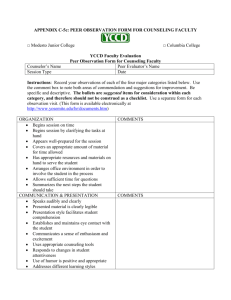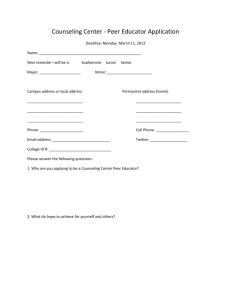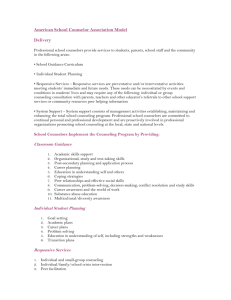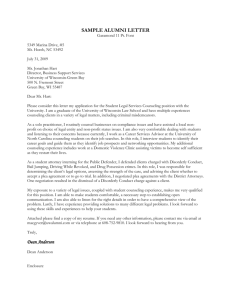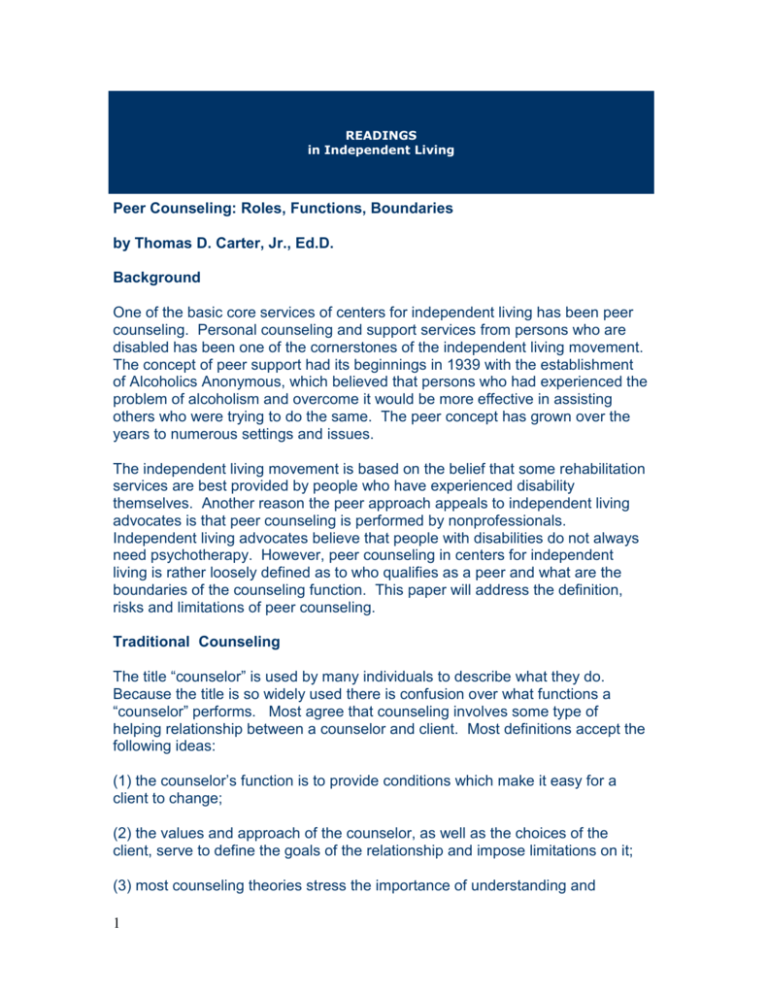
READINGS
in Independent Living
Peer Counseling: Roles, Functions, Boundaries
by Thomas D. Carter, Jr., Ed.D.
Background
One of the basic core services of centers for independent living has been peer
counseling. Personal counseling and support services from persons who are
disabled has been one of the cornerstones of the independent living movement.
The concept of peer support had its beginnings in 1939 with the establishment
of Alcoholics Anonymous, which believed that persons who had experienced the
problem of alcoholism and overcome it would be more effective in assisting
others who were trying to do the same. The peer concept has grown over the
years to numerous settings and issues.
The independent living movement is based on the belief that some rehabilitation
services are best provided by people who have experienced disability
themselves. Another reason the peer approach appeals to independent living
advocates is that peer counseling is performed by nonprofessionals.
Independent living advocates believe that people with disabilities do not always
need psychotherapy. However, peer counseling in centers for independent
living is rather loosely defined as to who qualifies as a peer and what are the
boundaries of the counseling function. This paper will address the definition,
risks and limitations of peer counseling.
Traditional Counseling
The title “counselor” is used by many individuals to describe what they do.
Because the title is so widely used there is confusion over what functions a
“counselor” performs. Most agree that counseling involves some type of
helping relationship between a counselor and client. Most definitions accept the
following ideas:
(1) the counselor’s function is to provide conditions which make it easy for a
client to change;
(2) the values and approach of the counselor, as well as the choices of the
client, serve to define the goals of the relationship and impose limitations on it;
(3) most counseling theories stress the importance of understanding and
1
listening in the relationship; and,
(4) the counseling relationship is always conducted in an atmosphere of mutual
respect and privacy. Without privacy and confidentiality, the client may not trust
the counselor or be open about problems.
Professional practitioners continue to argue over whether there is a difference
between counseling and psychotherapy. It is said that counseling deals with
normal clients having adjustment and problem-solving difficulties, while
psychotherapy deals with individuals having more serious emotional problems.
This position leads to the view that counseling is a form of psychotherapy for
“normal” clients.
On the other hand, “counseling” has been used to denote a wide range of
functions, including encouragement, information giving, advising, testing and
psychotherapy.
Psychological Aspects of Disability
Disability may involve physical, sensory, or mental losses; or environmental,
economic, and social/attitudinal barriers. These conditions can lead to serious
psychological stress. In professional counseling approaches, it is assumed that
these conditions have the same common psychological effect on all people with
disabilities, regardless of the type of disability. These psychological effects come
from two places. Some effects come from “inside” the person and are functions
of how the person thinks or feels about his/her disability. Other effects come
from “outside” the person and are functions of how other people think or feel
about the person’s disability. Another “outside” source of emotional stress is the
number of physical barriers the person must deal with. Both the “inside” and the
“outside” psychological effects can interact to make matters better or worse. For
example, a person with a disability who is accepted by others may better accept
him-/herself. A person with a disability who is facing a lot of physical barriers
may believe something is wrong with him/her and experience self-hatred; or a
person with a disability may reside in a barrier-free environment causing him/her
to minimize the disability.
Interventions
Professional interventions involve many types of practitioners, i.e., psychiatrists,
psychologists, social workers, rehabilitation counselors, speech therapists,
occupational therapists, physical therapists, nurses and physicians. The focus
of these professional interventions has been primarily on ways to help
individuals with disabilities improve their quality of life by addressing issues
coming from the “inside” or from the individual’s specific disability. Traditionally,
their strategies have included medical treatment/cures, individual/group
counseling, vocational counseling, educational counseling, social casework and
2
family counseling. However, in recent times interventions have shifted from the
specific disability and the “inside” effect to the “outside” effects created by
environmental and attitudinal barriers. This has led to interventions aimed at
eliminating these barriers.
Peer Counseling As An Intervention
Peer counseling, one of the services most commonly provided by centers for
independent living, is a uniquely different type of intervention. The difference
lies in the fact that peer counseling is provided by nonprofessional persons who
have a disability. This approach assumes that individuals who have experienced
a disability can better understand and relate to individuals trying to deal with
their disability. Additionally, it promotes a wellness model which considers the
clients to be normal, as opposed to a medical model which considers clients to
be sick. Clients are referred to as “consumers,” reinforcing the wellness model.
Peer counseling can be conducted in either a group or an individual setting and
has as its primary goal the promotion of the independent living philosophy and
encouraging consumers to embrace it. This philosophy is considered to be the
“magical therapeutic pathway” to healthy psychological adjustment. The
message is very simple: the problem is not you or your disability; the problem is
dependency on professionals and environmental/attitudinal barriers.
Consumers are urged to become self-advocates and to demand their rights as
citizens. They are also urged to try to change the system by becoming involved
in the legislative process and litigation if necessary.
People with disabilities experience nondisability related emotional stress at
about the same frequency as the population at large. As with the rest of the
population, the psychological consequences may range from minimal to severe.
Also, severe psychological consequences could result from disability related
emotional stress. The peer counseling approach can be a problem in these
situations. The problem results from a distrust of professionals by the consumer
and the peer counselor. Therefore, they may not seek the help of a
professional. Also, the nonprofessional aspect of peer counseling means that it
lacks the consumer safeguards of the professional approach, which prescribe
minimum standards of education, training, experience, and supervision for
certification and/or licensing. Traditional counseling as a “profession” is
regulated by ethical and legal rules. These rules are enforced by professional
associations, educational institutions, governmental licensing authorities and
legislation.
Because peer counseling is not a professional service and is offered to the
public on a non-fee basis, it is difficult to establish accountability in the case of
negative outcomes. Another major concern is that peer counselors may mix
their personal problems with their own disability with those of the consumer. This
can result in the peer counselor creating a problem in the mind of a consumer
3
that really does not exist for the consumer. Other ethical concerns are dual
relationships (being a counselor and having a business or romantic relationship
at the same time), autonomy (allowing independent actions contrary to the
thoughts of the counselor), privacy (setting where counseling takes place), and
confidentiality.
Given these concerns, which are due in part to the nonprofessional status of
peer counseling, there appears to be a need to define peer counseling more
explicitly. This could begin by dropping the term counseling and using a term
with less of a mental health connotation. Terms such as supporter, adviser, or
consultant would be appropriate. This change in terminology would eliminate
any suggestion or expectation that the relationship involves more than
information giving, coaching, listening, referring, teaching and modeling.
The peer supporter/adviser/consultant would still require training in
communication skills (especially active listening), assertiveness, the
independent living philosophy and the ethics of a helping relationship.
Individuals who are to function as peer supporters/advisers/consultants should
possess certain personal qualities such as emotional stability, self-reliance and
a sense of security. They should also understand the limits of their
responsibilities and have the ability to allow consumers to own their problems
regardless of the source. Knowing when to refer is a must. Issues such as
substance abuse, threats of violence, threats of suicide, and the consumer
residing in an abusive environment must be referred without hesitation.
The following are some suggestions for CILs that will help to minimize the
negative potentials of peer counseling:
1. Training of peer counselors should include which issues must be referred
and what the signs are for potential referable problems.
2. Establish a relationship with the local mental health center and state
rehabilitation agency on referral procedures and for training assistance on
the signs of mental health problems.
3. Conduct regular staffings with peer counselors to review consumer
progress and to determine if referable issues are evident.
4. When referral is made, continuous follow-up and contact with consumer
must be maintained in order not to lose the consumer.
5. One-on-one peer counseling relationships should be time-limited (10 to
12 weeks maximum). Reassign consumers to other peer counselors if
necessary. Favor “group” sessions over “individual” sessions. This
reduces the chances of dual and/or dependent relationships forming.
Peer counseling has been an important service provided by centers for
independent living. However, as happens in many agencies that provide
services over a long period of time, this service is at risk of exceeding its original
4
intent.
You can contact Thomas Carter at Stym@aol.com
©2000 ILRU
2323 S. Shepherd, Suite 1000
Houston, Texas 77019
713.520.0232 (v); 520.5136 (TTY); 520.5785 (fax)
ilru@ilru.org
This document may be reproduced for noncommercial use without prior
permission if the author and ILRU are cited.
The mission of the IL NET is to provide training and technical assistance on a
variety of issues central to independent living today--understanding the Rehab
Act, what the statewide independent living council is and how it can operate
most effectively, management issues for centers for independent living, systems
advocacy, computer networking, and others. Training activities are conducted
conference-style, via long-distance communication, webcasts, through widely
disseminated print and audio materials, and through the promotion of a strong
national network of centers and individuals in the independent living field.
ILRU is a program of The Institute for Rehabilitation and Research (TIRR), a
nationally recognized, free-standing medical rehabilitation facility for persons
with physical and cognitive disabilities. TIRR is part of TIRR Systems, which is a
not-for-profit corporation dedicated to providing a continuum of services to
individuals with disabilities.
Substantial support for development of this publication was provided by the
Rehabilitation Services Administration, U.S. Department of Education. The
content is the responsibility of ILRU and no official endorsement of the
Department of Education should be inferred.
©2005 ILRU Program, All rights reserved
Contact Us: IL NET or ILRU
713.520.0232 (Voice) 713.520.5136 (TTY) 713.520.5785 (Fax)
http://www.bcm.edu/ilru/html/publications/readings_in_IL/boundaries.html
5

